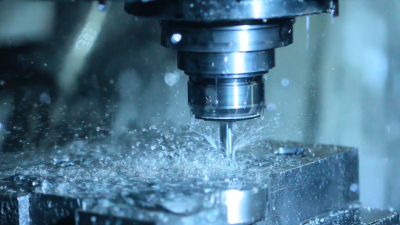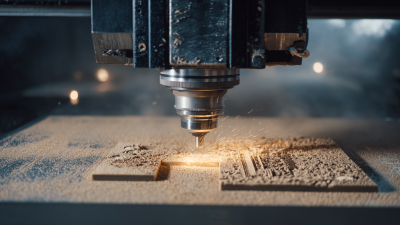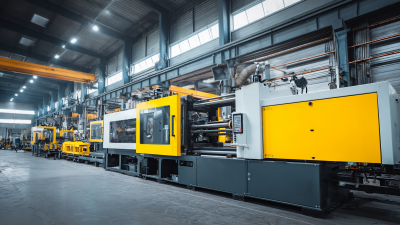
In today's rapidly evolving manufacturing landscape, optimizing CNC prototyping processes is essential for businesses aiming to maintain a competitive edge in global supply chains. According to a recent report by MarketsandMarkets, the CNC machine market is projected to grow from $63.43 billion in 2021 to $100.96 billion by 2026, underscoring the increasing reliance on precise and efficient prototyping techniques. As companies strive to enhance their product development timelines while reducing costs, adopting digital strategies becomes imperative. These strategies not only streamline operations but also facilitate seamless collaboration across different regions and teams. In this blog, we will explore five essential digital tips tailored to optimize your CNC prototyping process, ensuring that your supply chain remains agile, cost-effective, and capable of responding to market demands swiftly.

In the fast-paced world of global supply chains, effective data management strategies are essential for optimizing CNC prototyping processes. One key tip is to implement a centralized digital platform. By utilizing cloud-based solutions, teams can access and share real-time project data, ensuring everyone is on the same page. This reduces the risk of miscommunication and accelerates decision-making, ultimately streamlining the prototyping process.

Another important strategy is to leverage data analytics. By analyzing historical data and production metrics, companies can identify inefficiencies and areas for improvement within their CNC processes. This proactive approach not only enhances productivity but also aids in resource allocation, making it easier to adjust to changing demands in the supply chain.
Finally, maintaining robust cybersecurity measures is vital. As digital data becomes increasingly valuable, protecting sensitive information from breaches is paramount. Implementing encryption and regular security assessments can safeguard your data, ensuring that your CNC prototyping processes remain efficient and secure.
Embracing cloud-based tools in the CNC prototyping process offers significant advantages in the realm of collaborative design and feedback. These platforms enable teams, regardless of their geographical locations, to work together seamlessly on projects. With real-time access to design files and the ability to share insights instantly, collaboration becomes more efficient and targeted. This immediate feedback loop not only accelerates the design process but also helps in identifying potential issues early on, minimizing costly alterations later in the manufacturing phase.
Moreover, cloud-based solutions facilitate the integration of various stakeholders, from designers to engineers and manufacturers. This interconnectedness ensures that everyone involved has a clear understanding of the project goals and timelines. By utilizing sophisticated tools for version control and communication, teams can significantly reduce miscommunication and errors that typically arise in a traditional prototyping environment. Ultimately, leveraging these digital resources paves the way for more innovative designs and optimized supply chain management, reflecting a more agile and responsive approach to CNC prototyping.

The integration of IoT technologies in CNC prototyping processes is revolutionizing the way global supply chains operate. Real-time monitoring enabled by IoT devices allows manufacturers to track machine performance, production rates, and part quality as they happen. According to a report by IoT Analytics, the global IoT market is projected to reach $1.1 trillion by 2026, indicating the expanding role of connectivity in manufacturing environments. In terms of CNC machining, deploying IoT sensors can lead to a reduction in downtime by up to 30%, streamlining production flows and enhancing operational efficiency.
Furthermore, real-time data collection and analysis through IoT platforms enable proactive maintenance practices. A survey by Deloitte found that predictive maintenance can reduce maintenance costs by 10-40% and increase machinery life by 20-40%. This data-driven approach not only minimizes disruptions but also ensures that prototyping processes align closely with demand in global supply chains. As manufacturers increasingly adopt smart technologies, the ability to adapt swiftly to market changes while maintaining high-quality standards becomes a competitive edge in a fast-paced industry.
| Tip Number | Description | Potential Benefits | Implementation Timeframe | Cost Estimate |
|---|---|---|---|---|
| 1 | Integrate IoT Sensors for Machine Monitoring | Enhanced real-time data collection and equipment efficiency | 1-3 months | $5,000 - $15,000 |
| 2 | Use Cloud-Based CNC Management Software | Improved collaboration and data accessibility | 1 month | $1,000 - $3,000 per year |
| 3 | Implement Predictive Maintenance Strategies | Reduce downtime and maintenance costs | 3-6 months | $20,000 - $50,000 |
| 4 | Utilize Real-Time Analytics for Process Optimization | Data-driven decision making to improve efficiency | 2-4 months | $10,000 - $25,000 |
| 5 | Train Staff on Digital Tools and Technologies | Increased workforce efficiency and technology adoption | 1-2 months | $2,000 - $5,000 |
In the rapidly evolving landscape of global supply chains, utilizing advanced simulation software has become a game changer for enhancing the accuracy of CNC prototyping processes. By harnessing these powerful tools, companies can create highly detailed models to predict the behavior of prototypes under various conditions, significantly reducing the risk of errors during production. This proactive approach not only streamlines the prototyping phase but also minimizes costly revisions that can arise from design flaws.
Moreover, advanced simulation software enables teams to experiment with multiple design iterations in a virtual environment before any physical machining takes place. This not only saves time but also allows for a more thorough analysis of material properties and stress factors. As a result, manufacturers can make informed decisions and optimize their designs to better meet customer demands while maintaining high-quality standards. Embracing such technology not only enhances accuracy but also fosters innovation, ensuring a competitive edge in the increasingly interconnected global market.
Adopting agile methodologies in CNC prototyping can significantly enhance turnaround times, particularly within global supply chains. This approach emphasizes iterative development and encourages teams to adapt swiftly to changing project requirements. By integrating agile principles, companies can streamline their prototyping processes, leading to quicker iterations and more effective collaboration among cross-functional teams. This is particularly critical in industries like aerospace, where the demand for rapid manufacturing solutions is growing, as highlighted by ongoing advancements aimed at pushing the boundaries of space exploration.
Moreover, the implementation of agile methodologies can be further supported by leveraging digital tools and technologies. For instance, cloud-native production platforms facilitate seamless communication and allow for timely adjustments throughout the prototyping phase. As businesses increasingly adopt these agile strategies, they not only enhance operational efficiency but also improve their ability to respond to market dynamics. This transformation is vital in maintaining a competitive edge and meeting the ever-evolving demands of clients in industries that rely on rapid prototyping and innovation.







| Cookie | Duration | Description |
|---|---|---|
| cookielawinfo-checkbox-analytics | 11 months | This cookie is set by GDPR Cookie Consent plugin. The cookie is used to store the user consent for the cookies in the category "Analytics". |
| cookielawinfo-checkbox-functional | 11 months | The cookie is set by GDPR cookie consent to record the user consent for the cookies in the category "Functional". |
| cookielawinfo-checkbox-necessary | 11 months | This cookie is set by GDPR Cookie Consent plugin. The cookies is used to store the user consent for the cookies in the category "Necessary". |
| cookielawinfo-checkbox-others | 11 months | This cookie is set by GDPR Cookie Consent plugin. The cookie is used to store the user consent for the cookies in the category "Other. |
| cookielawinfo-checkbox-performance | 11 months | This cookie is set by GDPR Cookie Consent plugin. The cookie is used to store the user consent for the cookies in the category "Performance". |
| viewed_cookie_policy | 11 months | The cookie is set by the GDPR Cookie Consent plugin and is used to store whether or not user has consented to the use of cookies. It does not store any personal data. |

